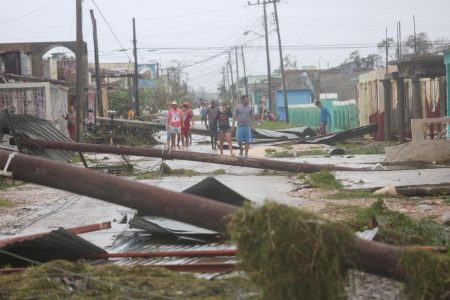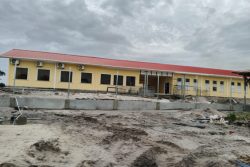By Vijay Prashad
Vijay Prashad is an Indian historian and journalist. He is the chief editor of Leftword Books (New Delhi). For the past twenty-five years, he has written regularly for Frontline (India), where this report first appeared.
This article was first carried on October 12, 2017 in Frontline (India).
 Hurricanes develop in the Atlantic Ocean and move across the cold water towards the warmer sea of the Caribbean. All that energy journeys, picking up steam, driving forward with immense force. This September, hurricanes Harvey, Irma, Jose, Katia and Maria thrust themselves into the Caribbean and devastated many of its islands as well as the coastline of the United States and Central America. One meteorologist, Phil Klotzbach of Colorado State University, suggested that this September was the most deadly hurricane month since 1893.
Hurricanes develop in the Atlantic Ocean and move across the cold water towards the warmer sea of the Caribbean. All that energy journeys, picking up steam, driving forward with immense force. This September, hurricanes Harvey, Irma, Jose, Katia and Maria thrust themselves into the Caribbean and devastated many of its islands as well as the coastline of the United States and Central America. One meteorologist, Phil Klotzbach of Colorado State University, suggested that this September was the most deadly hurricane month since 1893.
Changes in the world’s climate, scientists suggest, have made these Atlantic cyclones much more powerful than before. Warming waters increases the ability of the storms to draw in water vapour and to engorge themselves with more energy. These devastatingly formidable storms then drag the rising waters to produce dangerous storm surges that beat against coastlines and produce large-scale flooding.

Hurricane Irma, which arrived in the Caribbean Sea in early September, destroyed many of the small islands such as Anguilla, Barbuda and St. Martin. Prime Minister Gaston Browne of Antigua and Barbuda said that Barbuda, which housed short of 2,000 people, had become “barely habitable”. The government called for an evacuation of the island, which now has a population of zero. It has been abandoned. This country in the Lesser Antilles or the Leeward Islands faces the brunt of hurricanes since it is in the mouth of the Caribbean. Daniel Gibbs of the government of St. Martin, a French territory also in the Lesser Antilles, said that 95 per cent of the island had been destroyed. “It is an enormous catastrophe,” said Gibbs, who represents the island in the French parliament.
Cuba and Irma
Irma, a Category 5 hurricane—the strongest possible—struck Cuba with immense force in early September. The storm came fast and hard. The devastation was severe. In the small town of Moscu in the municipality of Esmeralda (Camaguey province), only 10 of its 289 houses remained standing. The Cuban journalist Yaditza del Sol Gonzalez reported for Granma that near Jiguey beach “the sea took it all”. The storm surge overcame the Malecon sea wall in Havana, sending water into its streets with ferocity. Havana, with its old buildings, suffered from flooding and power cuts. Ten people died, the majority of them in Havana. Cuba’s President Raul Castro took to the airwaves, calling for unity of the nation and for reconstruction of the island. “This is not the time to mourn,” Castro said, “but to build what the winds of Irma attempted to destroy.”
By all indications, the death toll in Cuba was remarkably low as was the devastation to the island’s infrastructure. Certainly, homes in the old part of Havana are brittle and parts of the infrastructure are in severe need of modernisation. But the island’s preparation for the hurricane and the general community spirit that prevails there saved it from total devastation. Tens of thousands of people had been evacuated from Havana in anticipation of the storm, and over a million people from across the island went into shelters. One such shelter was at the Karl Marx Vocational Pre-University in Matanzas, where volunteers gathered food, water and medical supplies for the evacuees.
The country’s pharmaceutical industry halted production of medicines a week before the storm in order to build up the stock of hydration salts, which were then distributed across the island. Electricity and gas supplies were cut before the storm came to the island, and measures were taken to protect the lines and transformers from the impact of the winds and the flooding. The government made sure to dispatch flour to state bakeries, which worked overtime to produce stocks of bread for the aftermath of the storm. Agricultural workers from Santiago de Cuba harvested their crops before they ripened in the field and distributed the produce.
Meanwhile, brigades and defence councils began to conduct search-and-rescue operations across the areas most affected by the hurricane. “The most important task is, and will be, the preservation of life,” said Dr Jose Luis Aparicio Suarez, a coordinator of one of the medical brigades. “The recovery will come later, gradually. Health and life are the absolute priorities.”
But rebuilding was not left to later. Radio Cadena Agramonte in Camaguey reported during the storm that electric workers had begun to restore power in the area. Within weeks, such workers restored the electric grid, which is not anyway in the best shape. The electric providers reported that the storm destroyed two high-tension pylons, downed 3,616 poles and 2,176 kilometres of power lines, and damaged 1,379 transformers and several substations. Today, almost the entire island has electrical power.
Just before Hurricane Irma hit Cuba, U.S. President Donald Trump renewed the embargo of the island. This means that Cuba will be denied crucial supplies needed for reconstruction, including financial assistance from multilateral organisations. Cuba’s finances cannot manage the reconstruction, but nonetheless the government has announced that its state budget will finance 50 per cent of the construction materials needed for the 158,554 homes that have been affected by the storm. Also, the government has said it will provide a 50 per cent discount on damaged household goods. For those who have had all their goods destroyed, the government has said it will cover 100 per cent of their expenses.
Puerto Rico and Maria
Hurricane Irma did not directly strike the U.S. territory of Puerto Rico, but it did knock out its power grid. More than a million customers lost access to power and half of the island’s hospitals went offline. This happened without any rainfall on the island and without a direct hit from Irma. Last July, the government-owned power company declared bankruptcy when it could no longer service its debt of $9 billion. There was no money to protect the grid, nor was there money to hastily get it back on its feet. Irma’s strike on Puerto Rico was a warning of what was to come.
Ten days later, with the power grid still in distress, Hurricane Maria, a Category 4 storm, struck Puerto Rico. Power went out across the island. Drinking water was no longer available and fuel vanished. The 3.4 million U.S. citizens of the island found themselves stranded in an apocalyptic nightmare. The official death toll was given as 16, although the Centre for Investigative Journalism (School of Law at the Interamerican University of Puerto Rico) says that there are already dozens of confirmed deaths, with the toll likely to rise to the hundreds. As hospitals are unable to function, the infirm are under danger of death. Dialysis has been halted; oxygen is not available. The Demographic Registry that certifies deaths has no power. It cannot do its work.
While Cuban journalists and brigades fanned Cuba to provide information to the authorities about destruction and reconstruction, Puerto Rico went dark. Communications collapsed and information about the damage was not easily available. While in Cuba the authorities tried to get exact information of the damage done to each home, in Puerto Rico the numbers thrown about were the price tag for recovery—between $40 billion and $85 billion is the estimated insurance claims that will likely be triggered by the devastation. It says a great deal about the different approaches to disaster: one makes sure each person is tended to and the other worries about the cost of the recovery.
Power company officials said it would take at least four, if not six, months for the power to be fully restored to Puerto Rico. This is on territory that is under U.S. government control, although according to a poll only 54 per cent of Americans know that Puerto Ricans are U.S. citizens. Recovery has been glacially slow. In Aguadilla, thousands of desperate people were given four bottles of water and four snacks. They are starving and frustrated. The price of water has skyrocketed from $2.99 to $10 in many parts of the island. Carmen Yulin Cruz, the Mayor of the capital, San Juan, said: “I’m begging, begging anyone that can hear us to save us from dying. If anybody out there is listening to us, we are dying and you are killing us with the inefficiency.”
Trump celebrated the “incredible” job his government had done. “The loss of life—it’s always tragic—but it’s been incredible, the results that we’ve had with respect to loss of life,” he said. “People can’t believe how successful that has been, relatively speaking.” He waived the Jones Act, which prevents ships from coming directly into Puerto Rico without going to a U.S. mainland port. But this will not be enough. Cuba has even offered to send its personnel to the island, but the Trump administration has not acknowledged the request.
Here is a tale of two islands, one a poor socialist state with infrastructure in grave need of modernisation and the other a territory of one of the richest countries in the world. One has slowly emerged out of the chaos caused by a hurricane’s wrath, while the other cannot see the light at the end of the tunnel.








